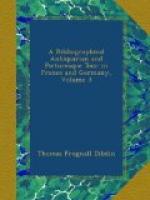About four o’clock we passed over the bridge of boats, across the Rhine, and changed horses at Ogersheim and Spire, sleeping at Germezsheim. The Rhine flows along the meadows which skirt the town of Spire; and while the horses were changing, we took a stroll about the cathedral. It is large, but of a motley style of architecture—and, in part, of a Moorish cast of character. Nothing but desolation appears about its exterior. The roof is sunk, and threatens to fall in every moment. No service (I understood) was performed within—but in a contiguous garden were the remains of a much older edifice, of an ecclesiastical character. Around, however, were the traces of devastation and havoc—the greater part arising from the bullets and cannon balls of the recent campaigns. It was impossible, however, for a typographical antiquary to pass through this town, without feeling some sensations approaching to a sort of pleasing melancholy: for HERE were born the TWO SPIRAS—or John and Vindelin de Spira—who introduced the art of printing into Venice. I do not suppose that there exists any relic of domestic architecture here old enough to have been contemporaneous with the period of their births.
The journey to Paris, through the route we took, was such—till we reached St. Avold, about two hundred and fifty English miles from the capital—as is never likely to induce me to repeat the attempt. The continuation of the chain of mountains called the Vosges, running northerly from Strasbourg downwards—renders the road wearisome, and in parts scarcely passable—as the government has recently paid no attention to its reparation. Landau, Weissenbourg, and Bitche are the principal fortified towns; the latter, indeed, boasts of a commanding fort—upon a very elevated piece of ground, ranked among the more successful efforts of Vauban. The German language continued chiefly to be spoken among the postilions and lower orders, till we left Forbach for St. Avold. At Landau, about three hundred and sixty miles from Paris, I parted with my valet—– for Strasbourg; under the impression that he would be glad to resume his acquaintance with me, on any future occasion: at the same time he seemed to long to be taken with us to London—a city, of all others, he said, he was desirous of seeing. He had also half imbibed the notion that its streets were paved with gold.
Metz is a noble city: finely situated, strongly fortified, and thickly inhabited. The Moselle encircles a portion of it in a very picturesque manner. The inn, called the Cheval Blanc, should rather be that of Cheval Noir—if it take its epithet from the colour of the interior—for a dirtier hotel can scarcely exist. It was a fine moonlight night when we left Metz, on a Sunday, resolving to sleep two stages on the road. The next day we dined at Dombasle, a stage beyond Verdun;




